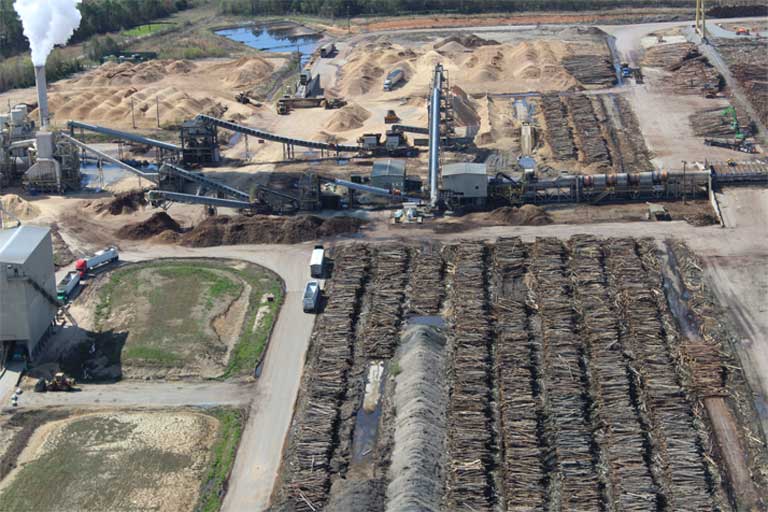- Research has conclusively shown that burning biomass for energy is not carbon neutral. However, a biomass carbon accounting loophole currently enforced by the UN and the Paris Agreement says that burning trees in the form of wood pellets produces zero emissions, and so is classified with solar and wind power.
- Mongabay gained an exclusive interview with Will Gardiner, CEO of Drax, the United Kingdom’s largest biomass energy plant. He dismisses the science and asserts that his firm and $7.6 billion industry are meeting “a responsibility to our community, our shareholders and our colleagues to be a part of the escalating climate crisis.”
- Bill Moomaw — an international researcher on biomass-for-energy, and author of forest reports for the UN Intergovernmental Panel on Climate Change — counters Gardiner’s arguments: “It’s all about the money. The wood pellet industry is a monster out of control,” he said when interviewed at COP25.
- Despite repeated pleas from scientists, COP25 climate summit negotiators in Madrid failed to address the biomass carbon accounting loophole, as they did at COP24 — a lapse that, if allowed to persist, could help push emissions above a 2 degree Celsius planetwide average increase that the UN says could bring climate catastrophe.

MADRID, Spain – Burning wood pellets to generate electricity instead of coal is not only better for the environment but also better for forests, the chief executive of Drax, the United Kingdom’s largest biomass plant, told Mongabay at the United Nations climate summit this week.
“I have a very, very clear view of this,” Will Gardiner said in an interview following a presentation at the UK’s pavilion sponsored by a group called Powering Past Coal. “It is absolutely better to use biomass than coal. The wood pellets we use come from forest ecosystems that are regrown.”
Gardiner, who was Drax’s chief financial officer before taking the top job in January 2018, then offered his view on forest ecology: “Fundamentally, we are part of a system that is helping forests to grow and prosper. A mature forest ends up bouncing off and doesn’t capture more carbon. A managed forest that keeps growing continues to capture more carbon.”
When told later of the CEO’s explanation of forest growth, Bill Moomaw — a top international researcher on biomass-for-energy, and author of forest reports for the UN Intergovernmental Panel on Climate Change (IPCC) — scoffed.
“Mature trees do not stop absorbing carbon,” he said. “It’s just the opposite. Carbon sequestration actually accelerates as a tree grows older. ‘Managed forests’ is usually code for trees farms full of longleaf pine that are cut [down] frequently and absorb a lot less carbon than mature forests.”
He added: “From an emissions standpoint, the UK would be better off burning coal and leaving those trees standing as long as possible.”

Carbon neutral?
Drax, the former coal-fired power plant in Yorkshire, is at the heart of one of the biggest environmental controversies — many scientists would argue crises — in the world of renewable energy. The problem was born with the 1997 Kyoto agreement. Because trees can be regrown, Kyoto negotiators decided biomass (the burning of trees to produce energy), was counted as being carbon neutral and classified as renewable, on par with wind and solar energy. That designation continues under the Paris Agreement.
As a result, countries that stopped burning coal and now burn wood in their power plants can zero out all emissions produced. Thus, the UK can claim that it is reducing its carbon emissions, when in fact the reduction is less than it reports — about 8% less at the current rate of wood-pellet usage, though a percentage that will grow in future.
This underreporting looks good on paper, but not in the atmosphere, and it comes at a time when record global emissions have supercharged planetary climate disasters, bringing catastrophic extreme weather, escalating sea-level rise, worsening wildfires, fast melting permafrost — and just last week — warnings of rapidly increasing ocean deoxygenation.
Worse still, studies and reports by Woods Hole Research Center, among others, have established that burning wood pellets actually generates more greenhouse gas emissions than burning coal. That’s because it takes more pellets to produce the same amount of energy as coal.
This UN biomass carbon accounting loophole, as scientists call it, has propelled a brand new industry to prominence, with the wood pellet global market topping $7.6 billion in 2017. That market is estimated to double to $15.4 billion by 2025 as Japan and South Korea ramp up biomass plants, according to Grand View Research.

“All about the money”
The target of those rising revenues? Thousands of acres of carbon-absorbing primary forests — hardwoods, bottomland and swampland trees, and pine lands – which are being converted into plantations, and pelletized mostly in the U.S. Southeast but also in old-growth forests in Estonia and Latvia in Eastern Europe. Environmentalists fear tropical forests, already stressed by rampant deforestation for mineral extraction and agribusiness, will soon become a biomass production market.
“It’s all about the money,” Moomaw said. “The wood pellet industry is a monster out of control.”
In the past, despite repeated pleas from researchers, the UN has resisted all attempts to close the biomass loophole. It’s been no different at COP25, where top negotiators ignored the issue altogether.
Gardiner supports this status quo. During his presentation, he told the audience: “Our journey beyond coal began more than a decade ago when we realized we have a responsibility to our community, our shareholders and our colleagues to be a part of the escalating climate crisis.
“At Drax, we did something that many believed wasn’t possible. We began to replace coal generation with renewable, sustainable biomass. Within a decade, we transformed [our power plant] into Europe’s largest decarbonization project.”
Drax, and biomass-for-energy plants across the European Union, are supported by hundreds of millions of dollars in taxpayer subsidies. The EU’s mandated Renewable Energy Directive calls biomass carbon neutral, thus giving the loophole the weight of law. Critics say this legal designation allows countries to use the on-paper-only emissions reductions to help meet their national Paris Agreement pledges, while not investing as much in wind and solar.
Gardiner claims that Drax’s carbon emissions are immediately offset by trees replanted in the U.S., which he says is where the Kyoto Protocol requires trees be harvested. When told that the United States never ratified Kyoto, and environmentalists have shown that native forests clear cut for pellets are rarely replanted; though some are replaced by plantations, Gardiner responded:
“You’re telling me I don’t believe what I’m saying. But I do believe what I’m saying, because it’s true. It’s absolutely true.”

Scientists speak out
Earlier this year, in an open letter to the EU, nearly 800 scientists railed against the biomass carbon neutrality loophole: “Even if forests are allowed to regrow, using wood deliberately for burning will increase carbon in the atmosphere and [increase] warming for decades even centuries — as many studies have shown — even when wood replaces coal, oil or natural gas. The reasons are fundamental and occur regardless of whether forest management is ‘sustainable.’”
That fundamental reason: the carbon from a tree burned today for energy is not absorbed immediately back into an ecosystem even if new trees are planted. Carbon neutrality happens, research shows, but it takes decades or centuries for those trees to sequester today’s emissions.
As the Madrid summit concludes, state governments want to showcase their successes. Misleading carbon accounting rules make it possible to reduce national emissions on paper simply by switching from coal (where emissions must be reported) to imported biomass (reported as zero emissions). “Forest biomass for energy is being hailed as the proverbial ‘silver bullet’ that delivers a win-win-win for policymakers, foresters and energy companies, because current rules permit it to be indiscriminately subsidized as a renewable energy. But for the climate, it is like jumping out of the frying pan into the fire,” says Dr William Gillett, Energy Programme Director for the European Academies’ Science Advisory Council (EASAC).
Asked if he believes scientists are wrong, Gardiner said, “I acknowledge that there are people who don’t agree [with biomass carbon neutrality], but you have to acknowledge that there are people who do. There are world-renowned scientists who agree. Many if not more than those who don’t agree.”
Moomaw just shook his head at those comments.
“I would like to see a study by just one scientist that actually demonstrates that burning wood pellets is carbon neutral within the timeframes we are talking about,” he said. “The IPCC says it’s not in the Fifth Assessment Report [on Climate Change]. If he thinks he’s smarter than IPCC scientists, then god bless him.”
Justin Catanoso, a professor of journalism at Wake Forest University in North Carolina, covers climate change and climate policy for Mongabay; this is his sixth UN climate summit. Follow him on Twitter @jcatanoso
Banner image caption: The UK’s Drax biomass burning power plant. Photo credit: RyanTaylor1986 on Visual hunt / CC BY-NC-ND
FEEDBACK: Use this form to send a message to the author of this post. If you want to post a public comment, you can do that at the bottom of the page.















